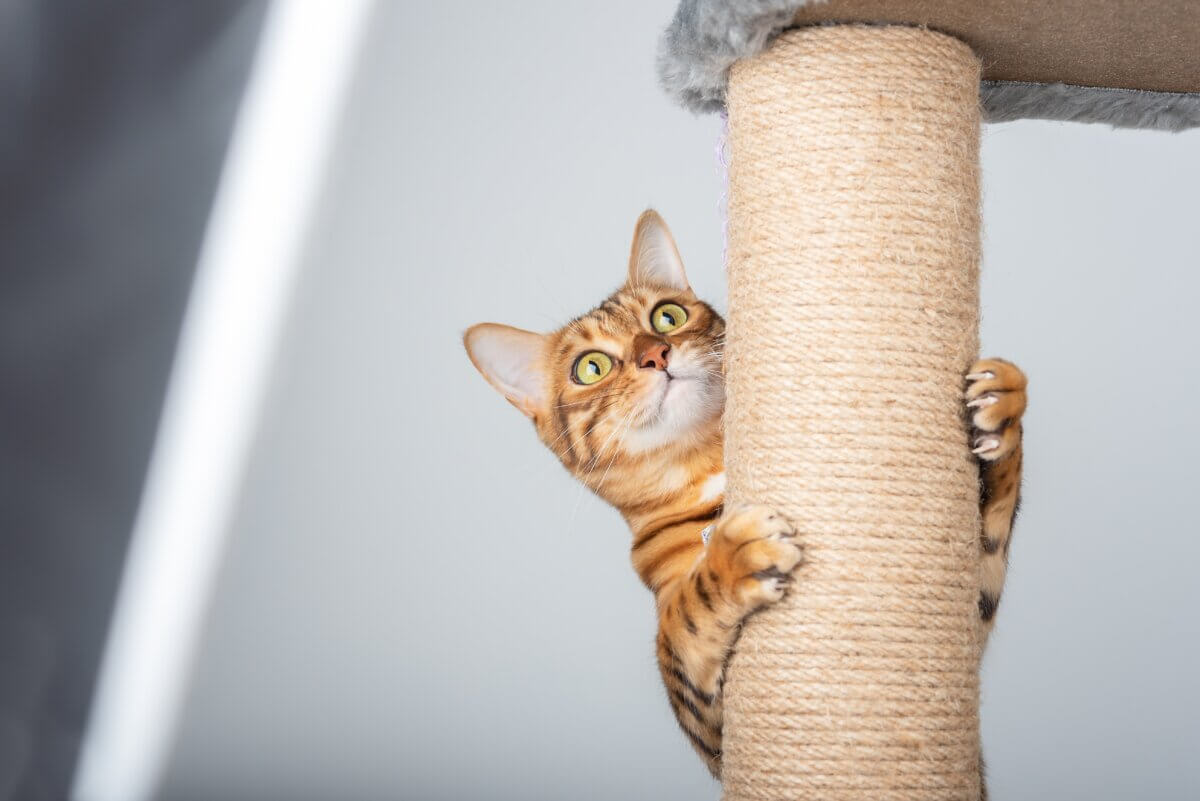
(Photo by bombermoon on Shutterstock)
ANKARA, Turkey — Every cat owner has likely experienced the frustration of coming home to find their favorite couch shredded or their new curtains in tatters. While scratching is a natural behavior for cats, it can become a major source of tension between pets and their human companions when directed at household items. Now, scientists are shedding light on the complex factors that may contribute to excessive scratching in domestic cats, offering hope for more harmonious human-feline relationships.
The study, published in Frontiers in Veterinary Science, took a multifaceted approach to understanding what they term “undesired scratching” in house cats. Unlike previous research that simply looked at whether cats scratched or not, this study aimed to evaluate both the frequency and intensity of scratching behavior. The results point to particular aspects of a cat's individual personality, daily routines, and living environment.
One of the most surprising findings is the impact of children in the household. Cats living in homes with children were more likely to exhibit high levels of scratching behavior. While the exact reasons for this aren't clear, the researchers suggest that the presence of children may increase stress levels for some cats, leading to more frequent and intense scratching as a coping mechanism.
The study also highlights the importance of play in managing scratching behavior, but not in the way you might expect. Cats described as more playful and those engaged in longer play sessions were actually more likely to scratch excessively. This counterintuitive finding might be explained by heightened arousal levels during play, which could spill over into increased marking behaviors like scratching.

Nocturnal activity was another key factor associated with higher scratching levels. Cats that were more active at night tended to scratch more, suggesting that disrupted sleep patterns or excess energy could contribute to the problem.
Personality traits play a role as well. Cats characterized as “disruptive” – a category that included aggressive and destructive behaviors – were significantly more likely to engage in excessive scratching. This points to a potential link between overall behavioral issues and scratching problems.
The placement of scratching posts emerged as a crucial environmental factor. Cats were more likely to use scratching posts when they were located in the same room where problem scratching occurred. This suggests that strategic placement of appropriate scratching surfaces could help redirect a cat's natural urge to scratch away from furniture and towards more acceptable targets.
“Our findings can help caregivers manage and redirect scratching to appropriate materials, which could help foster a more harmonious living environment for both cats and their caregivers,” says first author Dr. Yasemin Salgirli Demirbas, a veterinary researcher at Ankara University, in a statement. “Providing safe hiding places, elevated observation spots, and ample play opportunities can also help alleviate stress and engage the cat in more constructive activities.”

Rather than viewing excessive scratching as a simple behavioral problem, the study encourages a more holistic approach. Addressing a cat's overall stress levels, providing appropriate outlets for energy and natural behaviors, and carefully considering the home environment may all play a role in managing undesired scratching.
For example, in households with children, creating safe, quiet spaces where cats can retreat might help reduce stress-related scratching. Adjusting play routines to include shorter, more frequent sessions throughout the day could help manage arousal levels. For night-active cats, providing engaging toys or puzzle feeders might help burn off excess energy in more constructive ways.
The study also underscores the importance of understanding each cat as an individual. What works for one cat may not work for another, and strategies may need to be tailored based on a cat's unique personality and circumstances.
While the research offers promising new directions for managing scratching behavior, it's important to remember that scratching itself is a normal and necessary behavior for cats. It helps them maintain their claws, mark their territory, and stretch their muscles. The goal shouldn't be to eliminate scratching entirely but rather to direct it toward appropriate surfaces and manage excessive or destructive scratching.

“Understanding the underlying emotional motivations of scratching behavior, such as frustration, which seem to be linked to personality traits and environmental factors, allows caregivers to address these issues directly,” says Salgirli Demirbas.
What's clear is that if you think you're doomed, researchers say there are clear ways for more effective, cat-friendly solutions to common behavior problems. By taking a multifaceted approach that considers both the cat's needs and the human's perspective, we can work towards creating home environments where both species can thrive together – with furniture intact.
Paper Summary
Methodology
The researchers conducted an online survey of cat owners in France, collecting data on 1,211 cats. The questionnaire was divided into three main sections: owner demographics, information about the cat's daily life and behavior, and details about the cat's scratching behavior. To assess scratching, owners were asked to report on both the frequency and intensity of undesired scratching over the past week. The researchers then created a “scratching index” by multiplying the frequency and intensity scores. Cats were divided into high and low-scratching groups based on this index for analysis.
Key Results
The study found several factors significantly associated with higher levels of scratching:
- The presence of children in the household
- Longer play durations and higher playfulness
- Increased nocturnal activity
- Cats characterized as “disruptive” (including aggressive and destructive behaviors)
- Scratching posts located in the same room where problem scratching occurred
There was no significant difference in scratching levels based on breed, gender, neutering status, or body condition.

Study Limitations
The study relied on owner-reported data, which can be subjective and prone to bias. The cross-sectional design means that while associations between factors and scratching behavior can be identified, causality cannot be established. The study was conducted in France, so the results may not be generalizable to all populations. Additionally, details about child-cat interactions (such as the child's age or when the child was introduced to the household) were not explored, limiting understanding of this specific factor.
Discussion & Takeaways
This study highlights the complex, multifaceted nature of undesired scratching behavior in cats. It suggests that effective management of scratching problems may require a holistic approach that considers the cat's individual personality, daily routines, and living environment. Key takeaways include:
- Stress management may be crucial, especially in households with children.
- Play is important, but the timing and duration of play sessions may need to be carefully managed.
- Nighttime activity should be considered when addressing scratching issues.
- Cats with overall behavioral issues may be more prone to excessive scratching.
- Strategic placement of scratching posts in problem areas may help redirect scratching behavior.
The researchers emphasize the importance of addressing both the physical and social needs of cats to mitigate undesirable behaviors. Future research, particularly longitudinal studies, could help further clarify the causal relationships between these factors and scratching behavior.










